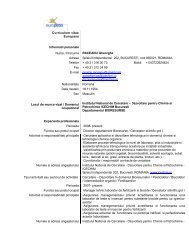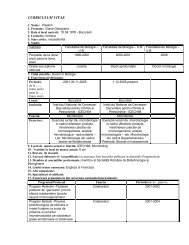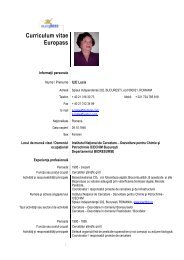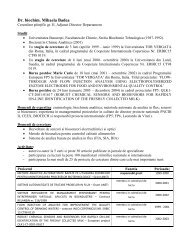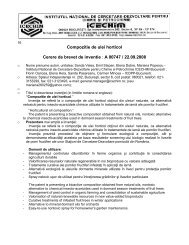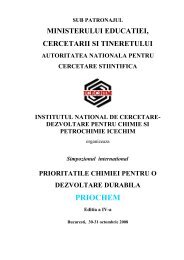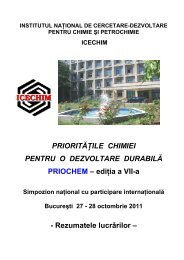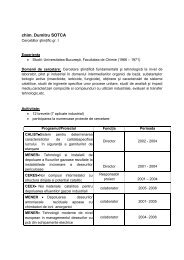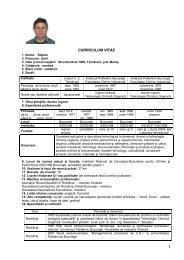INSTITUTUL NAÅ¢IONAL DE CERCETARE-DEZVOLTARE - ICECHIM
INSTITUTUL NAÅ¢IONAL DE CERCETARE-DEZVOLTARE - ICECHIM
INSTITUTUL NAÅ¢IONAL DE CERCETARE-DEZVOLTARE - ICECHIM
- No tags were found...
Create successful ePaper yourself
Turn your PDF publications into a flip-book with our unique Google optimized e-Paper software.
2. Multifunctional materials and nanocomposites - PPRUSSIAN BLUE MODIFIED SCREEN-PRINTED ELECTRO<strong>DE</strong>SFlorentina Hutanu 1, 2 , Emilia Ocnaru 2 , Melania-Liliana Arsene 2 , Gelu Vasilescu 2 ,Mihaela Badea-Doni 21 ’ Stefan cel Mare’ University of Suceava - Universitatii 13, 720229 Suceava, Romania, tel.0230 216147, fax 0230 520267. e-mail: florentinah@fia.usv.ro2National Institute for Research & Development in Chemistry & Petrochemistry, 202 Spl.Independentei 060021, Bucuresti, Romania, tel.021-315.32.99, fax: 021-312.34.93,e-mail: mihaela.badea@icechim.ro; ocnaru.emilia@ icechim.roBy modifying an electrode surface with Prussian Blue, it is possible to easily detect hydrogenperoxide at an applied potential around 0.0 V versus Ag/AgCl, thus making possible couplingwith oxidase enzymes while also avoiding or reducing electrochemical interferences. Inaddition, the use of Prussian Blue in the development of biosensors for food analysis hascaptured the interest of many research groups and led to improved methods for the detectionof glutamate, galactose, alcohol, fructosyl amine, formate, lysine and oxalate [1].A comparative study regarding different procedures for modifying the carbon screen-printedelectrodes (SPE) with Prussian Blue (PB) was carried out in this work. Several procedure forPB deposition on the SPE electrodes were tested: electrochemical deposition (galvanostatic,cyclic voltammetry) and chemical deposition by the reaction of K 3 [Fe(CN) 6 ] with FeCl 3 [2].Also, the influence of the pretreatment of SPE (+1.7V for 3 min in PBS, pH 7.4) and of thestabilization of PB deposited on SPE (by heating at 100°C) were evaluated.The developed sensors were optimized with respect to the lowest limit of detection achievedfor amperometric detection of H 2 O 2 . Analytical parameters, such as detection limit, linearityrange and sensitivity have been evaluated, together with operational and storage stability.[1] F. Ricci, G. Palleschi, Biosens. Bioelectron. 21 (2005) 389-407[2] F. Ricci, G. Paleschi, D. Moscone, Biosens. Bioelectron. 18 (2003) 165 - 174




